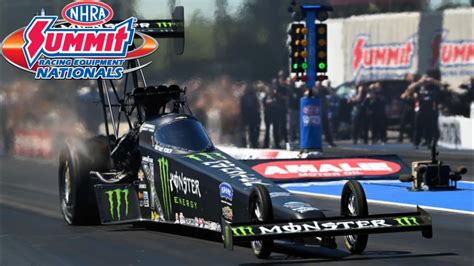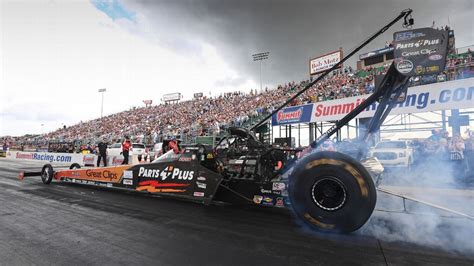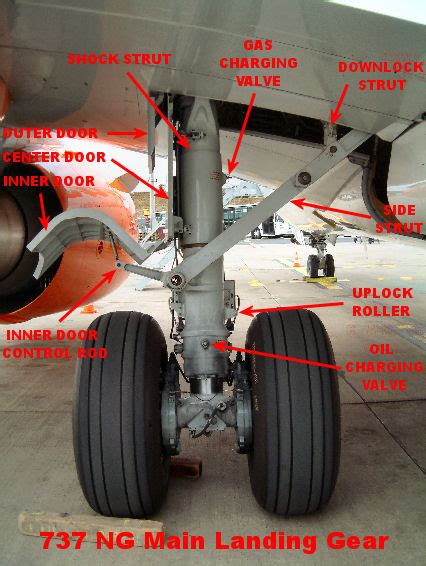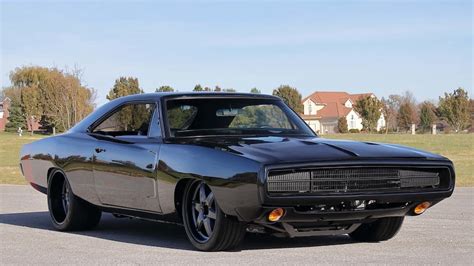
Tony Stewart’s Top Fuel dragster experienced a significant engine explosion during qualifying for the Summit Racing Equipment NHRA Nationals in Norwalk, Ohio, on Friday. The incident occurred during Stewart’s run, resulting in extensive damage to the vehicle but, fortunately, leaving the three-time NASCAR Cup Series champion uninjured.
The dramatic explosion took place near the finish line at Summit Motorsports Park. “Smoke filled the starting line after Stewart’s Top Fueler blew up,” as reported live during the event. The blast was powerful enough to visibly shake the dragster and send debris flying across the track. Safety personnel were immediately on the scene to assist Stewart, who emerged from the wreckage under his own power, confirming his safety.
“I’m fine,” Stewart stated shortly after the incident. “It just came apart. I felt it go, and the car started bouncing around.” He further explained that while unsettling, such incidents are part of the high-stakes nature of Top Fuel racing. “It’s part of the deal,” he added, acknowledging the inherent risks involved.
The explosion occurred as Stewart was nearing the end of his qualifying pass. While the exact cause of the engine failure is still under investigation by the team, initial assessments suggest a catastrophic mechanical failure within the engine itself. The force of the explosion ripped apart the engine block, sending shrapnel into the surrounding chassis and body panels.
The damage to Stewart’s Top Fuel dragster is substantial. The engine is a complete write-off, and significant repairs are needed to the chassis, bodywork, and associated components. The team faces a race against time to assess the full extent of the damage and determine whether they can repair the car in time to continue competing in the event.
This incident marks a stark reminder of the raw power and inherent risks associated with Top Fuel drag racing. These machines, capable of exceeding speeds of 330 mph in under four seconds, operate under extreme stress, pushing the limits of mechanical engineering and human endurance. Engine explosions, while not frequent, are a known hazard in the sport.
Despite the severity of the explosion, Stewart remained remarkably composed and philosophical about the experience. His immediate concern was for the safety of the crew and fellow competitors. He expressed gratitude that he was unharmed and acknowledged the professionalism and quick response of the NHRA safety team.
Stewart’s transition to NHRA Top Fuel racing has been a significant storyline in the motorsports world. Following a highly successful career in NASCAR, where he secured three Cup Series championships, Stewart has embraced the challenge of drag racing with enthusiasm and determination. His involvement has brought increased attention to the sport and attracted new fans.
The incident in Norwalk will undoubtedly present a setback for Stewart and his team. However, his resilience and competitive spirit suggest that he will be determined to overcome this challenge and return to the track as soon as possible. The team is expected to work tirelessly to repair or replace the damaged components and ensure that Stewart is back in action, continuing his pursuit of success in NHRA Top Fuel racing.
The Summit Racing Equipment NHRA Nationals at Norwalk continues without Stewart for the remainder of the event. Other top drivers are vying for the coveted Wally trophy, showcasing the incredible speed and thrilling competition that define NHRA drag racing. The event attracts thousands of fans and features a wide range of racing classes, from Top Fuel and Funny Car to Pro Stock and sportsman categories.
In-Depth Analysis:
The engine explosion suffered by Tony Stewart in Norwalk underscores the extreme conditions under which Top Fuel dragsters operate. These machines generate upwards of 11,000 horsepower, placing immense stress on every component. The engines are typically 500-cubic-inch, supercharged, and fueled by nitromethane, a highly volatile substance that provides the massive power output required to accelerate these vehicles to incredible speeds.
The typical lifespan of a Top Fuel engine is measured in seconds, not miles. During a single quarter-mile run, the engine undergoes stresses that would destroy a conventional automotive engine in a matter of minutes. The internal pressures and temperatures are so extreme that parts routinely fail, requiring meticulous inspection and frequent replacement.
The safety measures in place for Top Fuel racing are extensive and constantly evolving. Dragsters are equipped with robust roll cages, fire suppression systems, and advanced safety harnesses designed to protect the driver in the event of a crash or explosion. Drivers wear fire-resistant suits and helmets, and the NHRA mandates strict safety protocols for all aspects of racing operations.
The quick response of the NHRA safety team in Norwalk highlights the importance of these safety measures. These trained professionals are equipped to handle a wide range of emergencies, from fires and explosions to crashes and medical situations. Their presence ensures that drivers and spectators are protected to the greatest extent possible.
The financial implications of an engine explosion like the one experienced by Stewart are significant. A single Top Fuel engine can cost upwards of $75,000, and the associated damage to the chassis and bodywork can easily add tens of thousands of dollars to the repair bill. Teams often have multiple engines on hand to minimize downtime in the event of a failure, but a catastrophic explosion can still put a strain on resources.
The psychological impact of such an incident should not be underestimated. While Stewart emerged from the wreckage unharmed, the experience of being in a vehicle that explodes at high speed can be traumatic. Drivers often rely on mental toughness and experience to overcome such challenges and maintain their focus on racing.
Stewart’s transition from NASCAR to NHRA has been closely watched by fans and media alike. His success in NASCAR demonstrated his exceptional driving talent and competitive spirit, and his decision to try his hand at drag racing has generated considerable interest in the sport. His willingness to embrace new challenges and push his limits has made him a popular figure in the racing world.
The incident in Norwalk serves as a reminder of the unpredictable nature of motorsports. Despite the best efforts of engineers, mechanics, and drivers, mechanical failures and accidents can occur at any time. The ability to adapt to these challenges and persevere in the face of adversity is what separates the true champions from the rest.
Background Information:
Tony Stewart’s career spans across multiple disciplines of motorsports, including IndyCar, NASCAR, and now NHRA drag racing. His success in NASCAR is well-documented, with three Cup Series championships (2002, 2005, 2011) and 49 career wins. He is known for his aggressive driving style and his unwavering determination to win.
Stewart’s move to NHRA Top Fuel racing in 2024 marked a significant shift in his career. He joined forces with his wife, Leah Pruett, who is also a successful Top Fuel driver, forming a powerhouse team with high expectations. His transition has been met with enthusiasm from the drag racing community, who appreciate his passion for the sport and his willingness to learn.
Top Fuel drag racing is considered the pinnacle of drag racing, featuring the fastest and most powerful vehicles in the world. These cars can accelerate from 0 to over 330 mph in under four seconds, generating G-forces that are comparable to those experienced by fighter pilots. The races are short, intense, and require lightning-fast reflexes and nerves of steel.
The NHRA (National Hot Rod Association) is the primary sanctioning body for drag racing in the United States. It oversees a wide range of racing classes, from professional categories like Top Fuel and Funny Car to sportsman categories for amateur racers. The NHRA sets the rules and regulations for competition and ensures the safety of participants and spectators.
Summit Motorsports Park in Norwalk, Ohio, is a popular venue on the NHRA circuit. The track is known for its well-prepared racing surface and its enthusiastic fan base. The Summit Racing Equipment NHRA Nationals is a major event on the NHRA calendar, attracting top drivers and teams from around the country.
Expanded Context:
The engine explosion suffered by Tony Stewart is not an isolated incident in the world of Top Fuel racing. These types of failures are a recurring risk due to the extreme stress placed on the engines. In recent years, NHRA has invested heavily in research and development to improve engine reliability and enhance safety measures. However, the inherent nature of the sport means that failures will always be a possibility.
One of the key areas of focus has been on improving the strength and durability of engine components. Manufacturers are constantly developing new materials and designs to withstand the immense pressures and temperatures generated by Top Fuel engines. However, the quest for increased performance often comes at the expense of reliability, creating a constant trade-off for teams to manage.
Another area of focus has been on improving safety systems to protect drivers in the event of an engine explosion or crash. This includes the development of stronger roll cages, more effective fire suppression systems, and improved safety harnesses. The NHRA also mandates strict inspection and maintenance procedures to ensure that all vehicles meet the highest safety standards.
The cost of competing in Top Fuel racing is substantial, requiring significant financial investment in equipment, personnel, and travel. Teams rely on sponsorships and prize money to offset these costs, but even the most successful teams operate on tight budgets. An engine explosion can represent a major financial setback, forcing teams to make difficult decisions about repairs and upgrades.
The incident in Norwalk highlights the importance of teamwork and communication in motorsports. The crew members play a vital role in preparing the car for each run and ensuring that it is operating safely. The driver relies on the crew to provide accurate information and guidance, and the team works together to diagnose and resolve any problems that may arise.
The fans also play an important role in the success of NHRA drag racing. Their enthusiasm and support create a vibrant atmosphere at the track, and their passion for the sport helps to drive innovation and competition. The NHRA works hard to engage with fans through social media, online content, and interactive experiences at the track.
Looking ahead, the NHRA is committed to continuing to improve the safety and sustainability of drag racing. This includes exploring alternative fuels, developing more efficient engines, and reducing the environmental impact of the sport. The goal is to ensure that drag racing remains a thrilling and exciting form of motorsports for generations to come.
Quotes from Source Article:
- “Smoke filled the starting line after Stewart’s Top Fueler blew up.”
- “I’m fine,” Stewart stated shortly after the incident. “It just came apart. I felt it go, and the car started bouncing around.”
- “It’s part of the deal.”
Frequently Asked Questions (FAQ):
-
What caused Tony Stewart’s Top Fuel dragster to explode?
- The exact cause is under investigation, but initial assessments suggest a catastrophic mechanical failure within the engine. The immense stress and pressure on the engine components during a Top Fuel run can lead to such failures.
-
Was Tony Stewart injured in the explosion?
- No, fortunately, Tony Stewart was uninjured. He emerged from the wreckage under his own power and confirmed his well-being.
-
How much damage was done to the dragster?
- The damage is substantial. The engine is a complete write-off, and significant repairs are needed to the chassis, bodywork, and associated components. The team will need to assess the full extent of the damage.
-
Will Tony Stewart continue to compete in the Summit Racing Equipment NHRA Nationals?
- Due to the extent of the damage, Stewart did not continue to compete in the event in Norwalk. The team faced a race against time to determine if repairs were possible for later events.
-
What does this incident say about the safety of Top Fuel racing?
- While Top Fuel racing has inherent risks, the NHRA has extensive safety measures in place, including robust roll cages, fire suppression systems, and highly trained safety personnel. This incident underscores the importance of these safety measures and the constant efforts to improve them. While engine explosions are not frequent, they highlight the extreme conditions and stresses involved in the sport.
- What is the typical cost of a Top Fuel engine?
- A single Top Fuel engine can cost upwards of $75,000.
- How fast do Top Fuel dragsters typically go?
- Top Fuel dragsters can exceed speeds of 330 mph in under four seconds.
- What fuel do Top Fuel dragsters use?
- They are fueled by nitromethane, a highly volatile substance that provides the massive power output required to accelerate these vehicles to incredible speeds.
- What series did Tony Stewart previously race in before NHRA?
- Tony Stewart previously raced in NASCAR where he secured three Cup Series championships.
- Are engine explosions common in Top Fuel racing?
- Engine explosions, while not frequent, are a known hazard in the sport.









